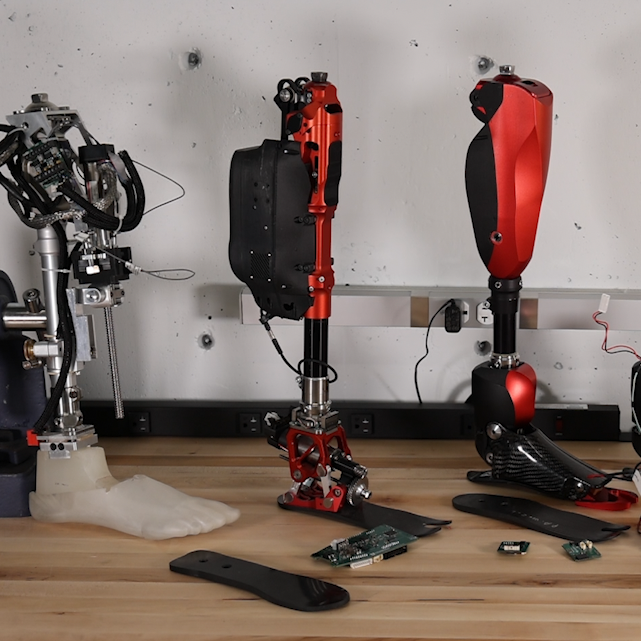Dr. Tommaso Lenzi, Dr. Lukas Gabert (post-doctoral fellow)
Ergonomics and Safety
W81XWH2110037 - T. Lenzi (PI)
Department of Defense, Congressionally Directed Medical Research Program (CDMRP-DMDRP-JC8- RESTORE)
04/01/2021-03/31/2025 -- $1,498,000
This research addresses the management, treatment, and restoration following service-related neuromusculoskeletal injuries. Specifically, we aim to find out whether a lightweight powered knee-ankle prosthesis can help individuals with above-knee amputations walk more naturally at home and in the community compared to available passive prostheses.
Amputation of the leg is one of the most debilitating types of combat-related injury. The best treatment for lower-limb amputation is the use of an artificial leg, or prosthesis. However, the prostheses that are currently available are poor replacements for a missing biological leg. Most prostheses are passive, meaning they don’t provide any power to help the user propel the body during walking. This makes walking around the home and community difficult, especially for people with amputations above the knee. This is because they need to use far more energy while walking with a prosthesis than able-bodied people. Moreover, individuals using available prostheses cannot walk in a natural way, which can cause injuries to other parts of the body. Some newer prostheses can provide power, thanks to electrical motors and batteries. Unfortunately, powered prostheses are much heavier than passive devices. Walking with a heavy prosthesis is very difficult, especially for above-knee amputees. A heavy prosthesis cancels out the potential benefits of providing power, so that these devices have limited usefulness in the real world. After more than 10 years of research and five years on the market, powered lower-limb prostheses are not widely used.
To address these issues, we have developed novel lightweight actuators to power the prosthesis joints. These actuators are much smaller and more efficient than the conventional system used in available powered prostheses. Our new actuators require less power, allowing us to use smaller and lighter batteries without affecting the leg’s performance. Because of these smaller batteries, we were able to reduce the overall size and weight of our powered prosthesis so that it is easier to use. Our innovations resulted in a lightweight powered ankle and knee prosthesis that weighs half as much as any powered device previously developed, while providing even more torque and speed. By improving the ability to walk, a lightweight powered prosthesis may provide immediate health benefits to people with lower-limb amputations, enabling them to lead more active and independent lives. Being able to walk more efficiently can prevent secondary health problems that often affect prosthesis users, such as back pain and osteoarthritis.
Our preliminary experiments with people with above-knee amputations have shown that using our lightweight powered prosthesis improves the way people walk compared to walking with a passive device. Our device also empowers amputees to excel at activities, such as climbing stairs and ramps, squatting, and even lunging, that would be challenging or even impossible with a passive prosthesis. Based on these results, we expect that providing amputee subjects with a lightweight powered prosthesis will help them walk more naturally at home and in the community. We are now refining our prosthesis design to make it more robust so that it can withstand normal wear and tear during home use. We also want to understand whether both the knee and ankle need to be powered in order to benefit users. To do this, we ask individuals with amputations to do a variety of activities in the laboratory while wearing the powered prosthesis, which will be adjusted to provide power at one or both joints. During these tests, we monitor how their movements change based on the configuration of the powered prosthesis. Finally, we ask subjects to use our powered prosthesis at home for 30 days to see how it affects their daily lives. By using sensors in the powered leg as well as questionnaires to gauge the user’s perception, we will understand whether this new prosthesis technology is effective when it matters the most — at home and in the community. If successful, the long-term impact will be to provide a clinically useful prosthesis that improves the ability of people to walk compared to available prostheses. This test would enable both wounded soldiers and civilians with lower-limb amputation to pursue work and leisure endeavors — possibly even enabling more service personnel to return to active duty, if desired — while reducing the secondary health effects of passive prosthesis use.
Publications:
- A lightweight robotic leg prosthesis replicating the biomechanics of the knee, ankle, and toe joint
- Effect of Increasing Assistance from a Powered Prosthesis on Weight-Bearing Symmetry, Effort, and Speed during Stand-Up in Individuals with Above-Knee Amputation
- Powered knee and ankle prostheses enable natural ambulation on level ground and stairs for individuals with bilateral above-knee amputation: a case study
- Powered Knee and Ankle Prosthesis With Adaptive Control Enables Climbing Stairs With Different Stair Heights, Cadences, and Gait Patterns




 © 2025 Rocky Mountain Center for Occupational and Environmental Health
© 2025 Rocky Mountain Center for Occupational and Environmental Health